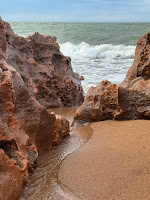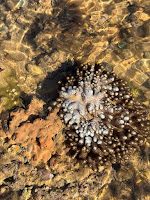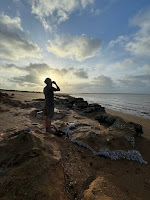Peter returned safely from his jaunt back to New Zealand. All was well at the ranch, and he managed to catch up with the boys while he was there. It was quite a hot week there too, so he didn't suffer in the chill of a Marlborough summer! The Pilbara is definitely showing signs of a seasonal change - shorter days, lots of evening thunderstorms and lightening, day temperatures generally hovering around 33 degrees, occasional rain showers. When we drove to Karratha last week, there was water in the previously dry riverbeds and even a few small pockets of standing water. I'm hoping the wildflowers will pop up soon too. And I'm very much hoping that the humidity will sod off.
Ironically, I've bought a jersey to wear at work. The aircon in the L&D annexe, including my little office, has been working its arse off, keeping the place intermittently uncomfortably cold. There are other zones in the hospital that are also fridge-like. It turns out that the dastardly humidity is stuffing up the air quality in operating theatre, to the extent that it's been unsafe from an infection control perspective. Engineers have sorted this out, but the consequence is rogue aircon elsewhere in the hospital. I sometimes go outside for a quick walk to warm up and end up feeling lightly grilled.
Dusk holds dark shadows and far too much potential for slithery and creepy critters to be out and about looking for a bite or two. Daily beach walks are still a thing, though the shorter days mean we have to leave home earlier to be out in daylight. Currently that gives us until around 6:15pm, but that will get even earlier over the next few months (no daylight saving in WA). The plus side of this is that we get to see lots of beautiful sunsets. And that provides opportunities for me to practice some photography techniques learned from an online iPhone photography course. I'm really enjoying this, and quite aware of how boringly snap-happy it's making me. So be it.
The Port Hedland reefs are sources of endless fascination (and nowadays, endless photos). The rocky formations are mesmerising and ever-changing with the tides. The reefs that are totally immersed at high tide are beautifully encrusted with oyster shells. These create a jewel-like image when the sun is shining on them, enhanced by light reflected from sea salt. Millions of little rivulets of tidal flow are in constant motion across the sandy zones. I can (and do) spend hours just exploring and taking it all in. One evening when we were reef-hopping, Peter spotted the unmistakable sight of a shark's dorsal fin in the shallow coastline. It was a reef shark, around a metre long, and was soon joined by half a dozen of its mates. They were an absolute delight to watch, but I really wasn't tempted to join them. Funnily enough, nor was Peter. They swam along and back several times, presumably rounding up dinner. Or as I prefer to believe, happily playing.
Another cyclone didn't make landfall but definitely churned up the ocean. The sea was choppy for days, and lots of weed and other debris were washed up onto the beaches. On Cemetery and Pretty Pool beaches, heaps of jellyfish were strewn on the shoreline, either dying or already dead. Also a puffed-up puffer fish and a gazillion cuttlefish 'bones'. Apparently, cuttlefish live fast and die young after mating and egg-laying - so what we're seeing is a seasonal post-procreation event rather than a mass suicide.
Peter's full-face snorkel arrived and it's kinda working for him. He can float around and observe, but still can't get enough breath to actually swim. We've snorkelled a few times at Pretty Pool and unfortunately the water hasn't yet been clear enough to see very far. One time the current of the incoming tide was so strong that we could barely stand up, let alone stay still underwater to see anything. At other times, only close up viewing has been possible, so we won't be getting any visible warning that more distant sharks and crocs are closing in! I have an underwater iPhone case and hope to get some fab sea life shots, but as the crappy photos attest, there's obviously more to it than just getting the equipment. Clear water will definitely help so hope we can find some of that on our travels someday.
Corals are abundant along some stretches of beach, particularly Cemetery Beach where the photos were taken. They are very much more like the ones on the east of Australia and it's really lovely to see that the mining industry hasn't totally decimated them here. The rock pools host so many life forms, truly amazing ecosystems. Octopus Soccer is still keeping us entertained and serves the purpose of focusing your eyes and mind on what's in each pool. You don't want to accidentally surprise an octopus (or a jellyfish for that matter).
Sharon the Osprey still visits from time to time, and usually calls to alert us to her presence. We see many ospreys on our beach walks, and new birds on Peter’s list include mangrove fantails, masked lapwings, stone curlews, Australian bittern, and once (possibly) a brown goshawk. Lizards of many kinds and sizes are also common sightings and always a pleasure (unless they're squished on the road). Cattle and kangaroos are around too and can cause nasty vehicle accidents when they drift onto the roads in poor light. There is fencing but much of it doesn't look like it'd hold any beast back.
Sand bubbler crabs feed by filtering sand through their mouthparts, leaving behind balls of sand that are broken up by the incoming tide. There are so many of these that there must be millions more sand bubbler crabs than you can shake a stick at AND they must constantly spit out sand balls. Apparently, the pretty patterns they create from sand ball-art are mere coincidence, though that’s hard to believe. Alas the photo isn't great at conveying the beauty of their intricate designs (yay - more photos needed!). This Caper White butterfly was on the beach, one of many that we're starting to see this month. Every butterfly is a happy reminder of Nick; we hope this is a correct identification of this particular species. Also hoping this means that there may actually be native caper bushes around - they have the most amazing flowers. So far, most of the butterflies we've seen have been mainly white, but it looks like there are several very colourful species in this part of the world.
Next month will be a series of traveling mini adventures for us, and I'm excited about what's ahead. First up will be glamping in Karijini over Easter, then a workshop in Perth followed by a stint upskilling in the Special Care Nursery in Bunbury. Peter will be traveling down with me so will be able to explore Southwest WA while I work. Then back to Hedland for a few days before hitting the North West Coastal Highway for about 800kms until we reach Exmouth. This will be my first real holiday since arriving in Aus and I'm totally ready for it. We'll split the travel over 2 days each way and have a few nights in our roof top tent in Exmouth. The main event will be swimming with whale sharks, but we'll also explore the awesome Cape Range National Park. We've booked another holiday in July/August to Broome, spending yet more of the kid's inheritance. Friends Clare and Roy will be flying in from NZ to join us as part of their WA holiday, so likely some traditional beach camel-riding will be on the cards. And gin.

























No comments:
Post a Comment